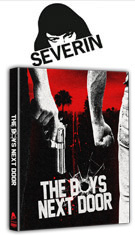
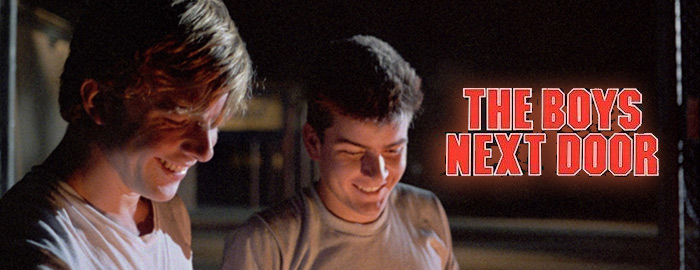
Color, 1985, 90 mins. 51 secs.
Directed by Penelope Spheeris
Starring Charlie Sheen, Maxwell Caulfield, Christopher McDonald, Patti D'Arbanville, Hank Garrett, Moon Zappa
Severin Films (UHD & Blu-ray) (US R0 4K/HD), CMV Laservision (Blu-ray & DVD) (Germany R0 HD/PAL), Anchor Bay (DVD) (US R1 NTSC) / WS (1.85:1) (16:9)
After making a splash 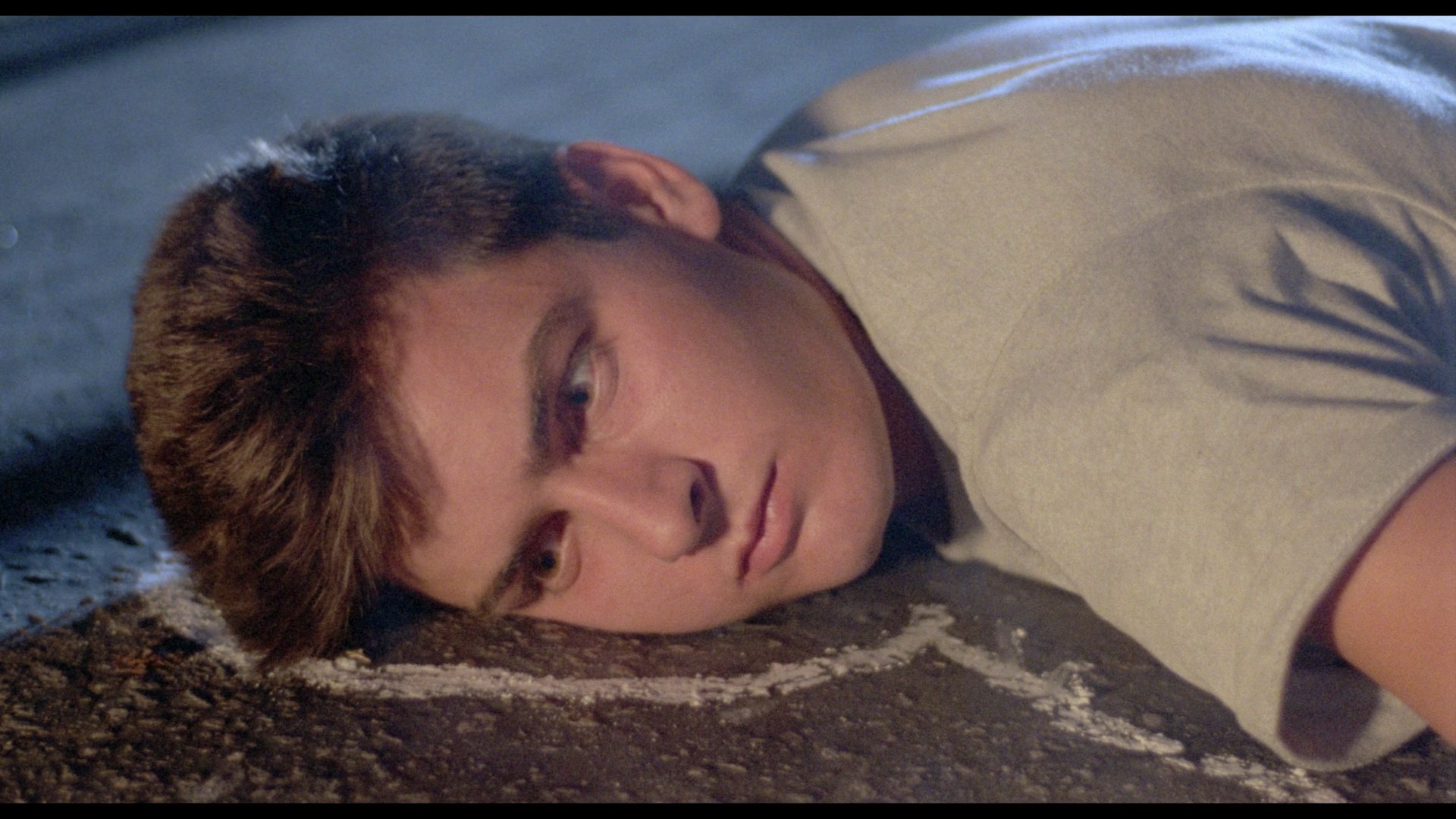 with her first The Decline of Western Civilization documentary and the acclaimed Suburbia for Roger Corman,
with her first The Decline of Western Civilization documentary and the acclaimed Suburbia for Roger Corman, 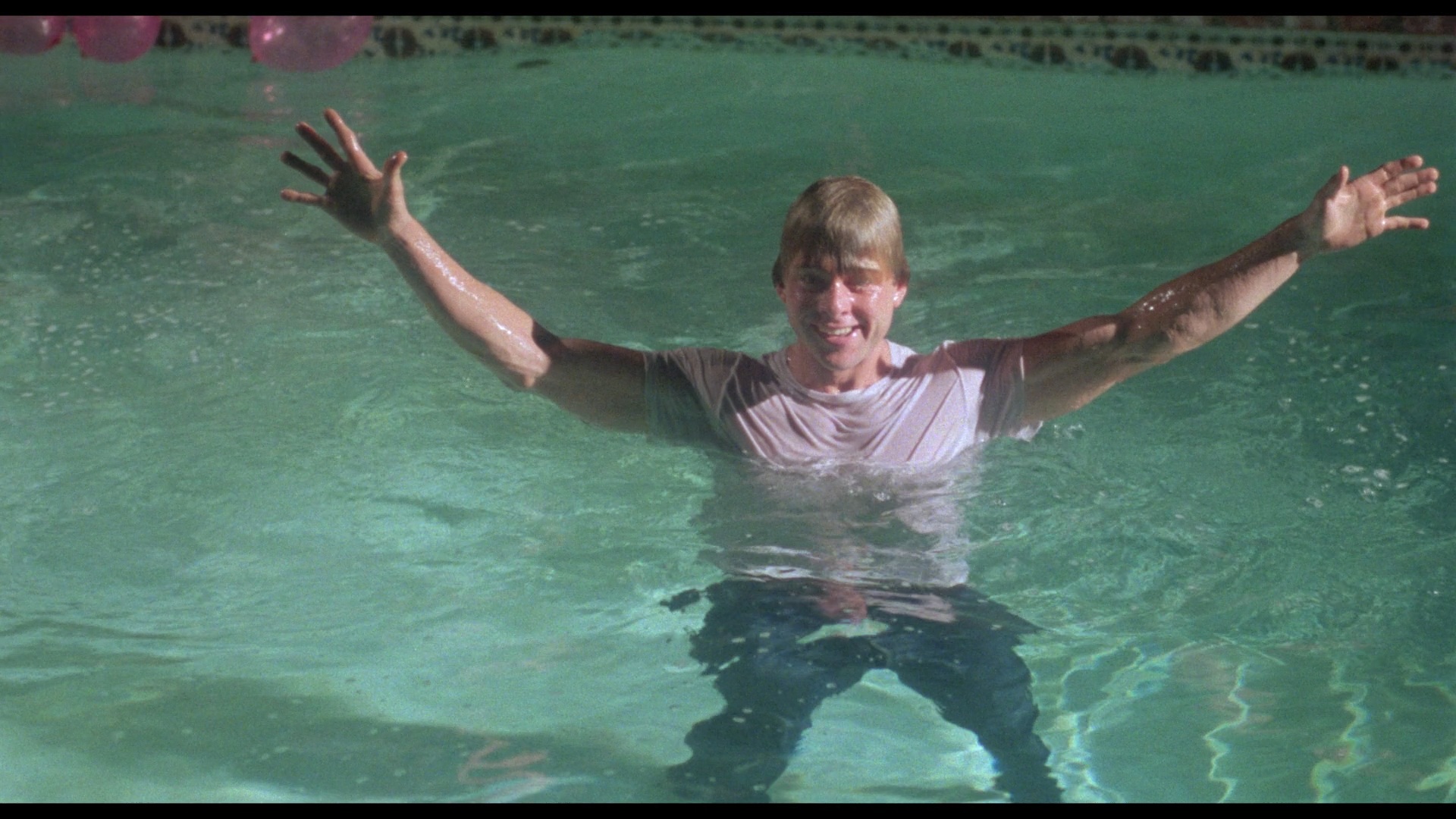 unpredictable pop culture chronicler Penelope Spheeris turned her eye to teen crime with another counterculture-infused feature. In 1985, teen movies hadn't quite gone noir yet and were still in their optimistic John Hughes phase; titles like Heathers, Wisdom, Kansas, Out of Bounds, and No Man's Land were lurking just around the corner. One of the first and best out of the gate, The Boys Next Door is an extremely dark buddy road movie written by the team of Glen Morgan and James Wong, who went on to glory with 21 Jump Street, The X-Files, and Final Destination. Essentially it's a crime spree film like Gun Crazy updated for the Reagan era, depicting how the American promise of prosperity for all very quickly turned out to be a hollow one for millions of rootless middle- and lower-class youths. Seen today it's also impossible not to think about the real-life dumpster fire of star Charlie Sheen's life as well as the dramatic increase in teenage homicides since then, and if you were told this was based on a true crime case, it would be very easy to believe.
unpredictable pop culture chronicler Penelope Spheeris turned her eye to teen crime with another counterculture-infused feature. In 1985, teen movies hadn't quite gone noir yet and were still in their optimistic John Hughes phase; titles like Heathers, Wisdom, Kansas, Out of Bounds, and No Man's Land were lurking just around the corner. One of the first and best out of the gate, The Boys Next Door is an extremely dark buddy road movie written by the team of Glen Morgan and James Wong, who went on to glory with 21 Jump Street, The X-Files, and Final Destination. Essentially it's a crime spree film like Gun Crazy updated for the Reagan era, depicting how the American promise of prosperity for all very quickly turned out to be a hollow one for millions of rootless middle- and lower-class youths. Seen today it's also impossible not to think about the real-life dumpster fire of star Charlie Sheen's life as well as the dramatic increase in teenage homicides since then, and if you were told this was based on a true crime case, it would be very easy to believe.
After a questionable 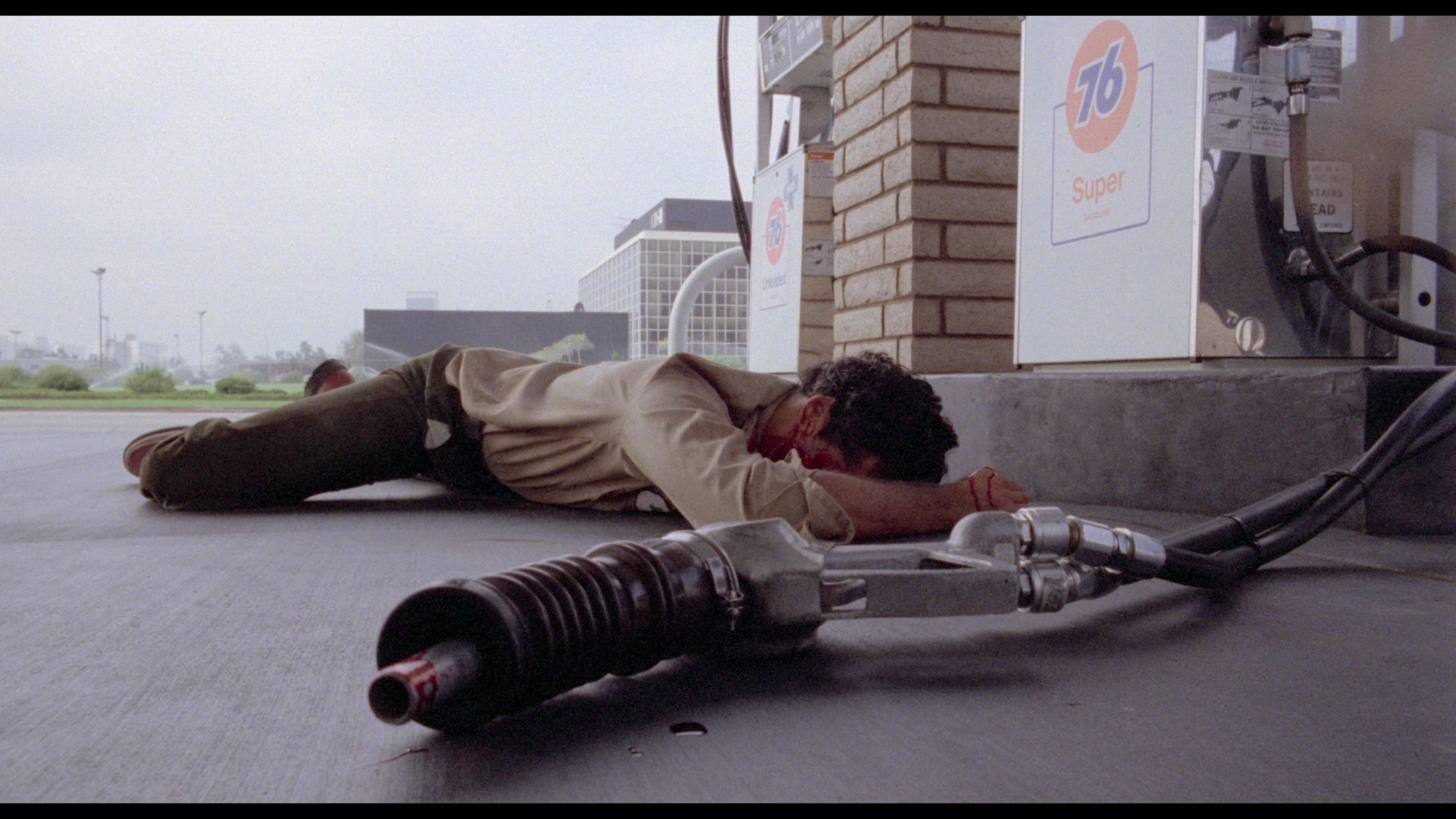 main title sequence showcasing real-life serial killers (imposed by producer Sandy Howard of Angel fame), we meet our two protagonists on the cusp of graduating from high school: Roy (Caulfield) and Bo (Sheen), who draw a prank
main title sequence showcasing real-life serial killers (imposed by producer Sandy Howard of Angel fame), we meet our two protagonists on the cusp of graduating from high school: Roy (Caulfield) and Bo (Sheen), who draw a prank 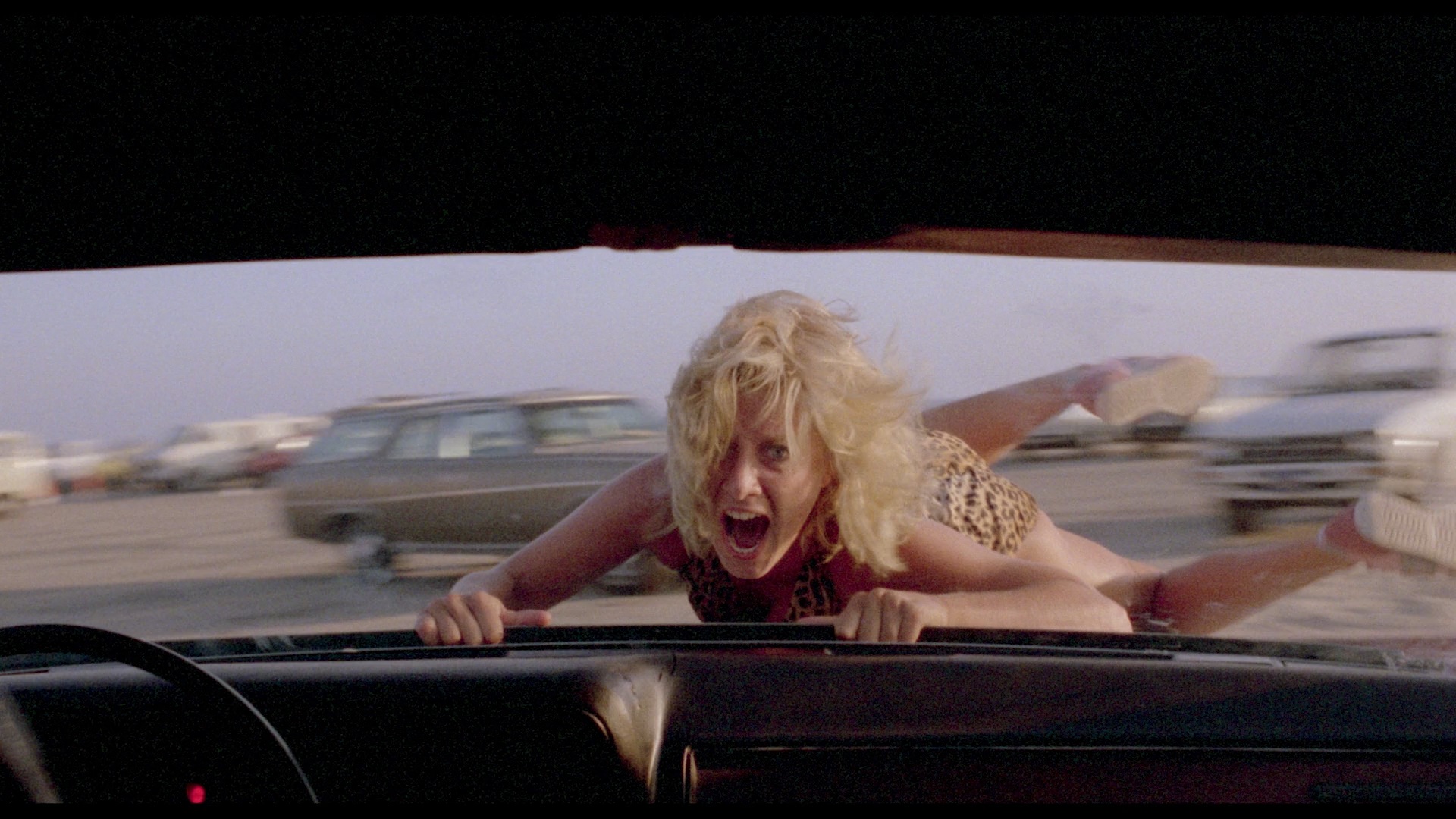 dead body outline at school to cause a ruckus. Confronted with either heading into the military or taking manual labor jobs, they decide to use their graduation money after an uncomfortable pool party to take an impulsive trip to L.A. and inflict escalating acts of violence against those they encounter. A savage beating at a gas station puts the police (including Caulfield's previous Grease 2 co-star, Christopher McDonald) on their trail, and what was supposed to be a trip to the beach and Hollywood turns into a manhunt and further brutal robberies.
dead body outline at school to cause a ruckus. Confronted with either heading into the military or taking manual labor jobs, they decide to use their graduation money after an uncomfortable pool party to take an impulsive trip to L.A. and inflict escalating acts of violence against those they encounter. A savage beating at a gas station puts the police (including Caulfield's previous Grease 2 co-star, Christopher McDonald) on their trail, and what was supposed to be a trip to the beach and Hollywood turns into a manhunt and further brutal robberies.
Though it doesn't reinvent the criminals on the run narrative, The Boys Next Door feels extremely fresh thanks to the strong central performances, an unexpected and very Spheeris soundtrack (The Cramps!), and a vivid depiction of L.A. when it was shot in 1984. Most audiences and critics at the time turned a strangely blind eye to the eroticizing of male actors at the time despite it being very obvious in many horror and action films, and this one pushes it to the point where you simply can't ignore it. The depiction of a shirtless, smoldering Caulfield on the movie poster itself is a pretty big clue, and the homoerotic undercurrents become extremely disturbing during a lengthy sequence at a gay bar and subsequent robbery involving a man with other plans for the evening. The colorful supporting cast delivers as well including a small but memorable bit near the beginning for a post-"Valley Girl" Moon Zappa and the always intense Patti D'Arbanville as one of the potential victims.
Initially released on VHS by New World (with the usual budget reissue from Starmaker), The Boys Next Door was an early entry in the company's DVD editions from Anchor Bay in 2001 featuring the trailer, a widescreen transfer, and an excellent commentary with Spheeris and 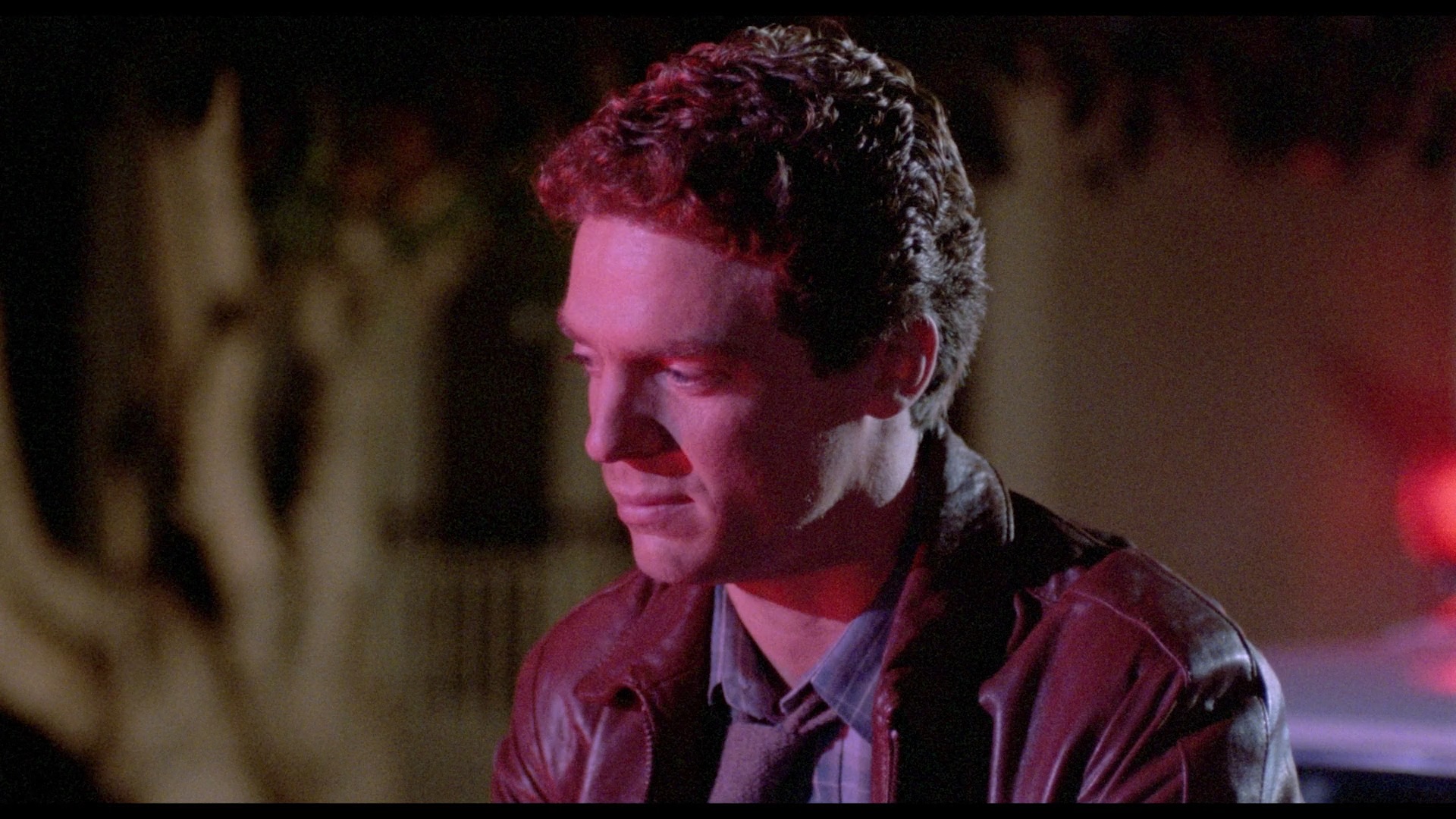 Caulfield. It's a great chronicle of the making of the film including other prospective cast members (like Crispin Glover), the changes necessitated to avoid an X rating especially in the gas station scene, the stories behind some of the song choices, the film's roles in their lives since its release, and lots more. Severin Films brought the film to Blu-ray in 2019 with a reissue in 2025 as a UHD and Blu-ray set, with the latter obviously being the way to go since the HDR10-augmented transfer looks about as crisp and vivid as you could possibly want. The DTS-HD MA 5.1 and 2.0 stereo English tracks both sound good with the music obviously getting most of the separation here,
Caulfield. It's a great chronicle of the making of the film including other prospective cast members (like Crispin Glover), the changes necessitated to avoid an X rating especially in the gas station scene, the stories behind some of the song choices, the film's roles in their lives since its release, and lots more. Severin Films brought the film to Blu-ray in 2019 with a reissue in 2025 as a UHD and Blu-ray set, with the latter obviously being the way to go since the HDR10-augmented transfer looks about as crisp and vivid as you could possibly want. The DTS-HD MA 5.1 and 2.0 stereo English tracks both sound good with the music obviously getting most of the separation here, 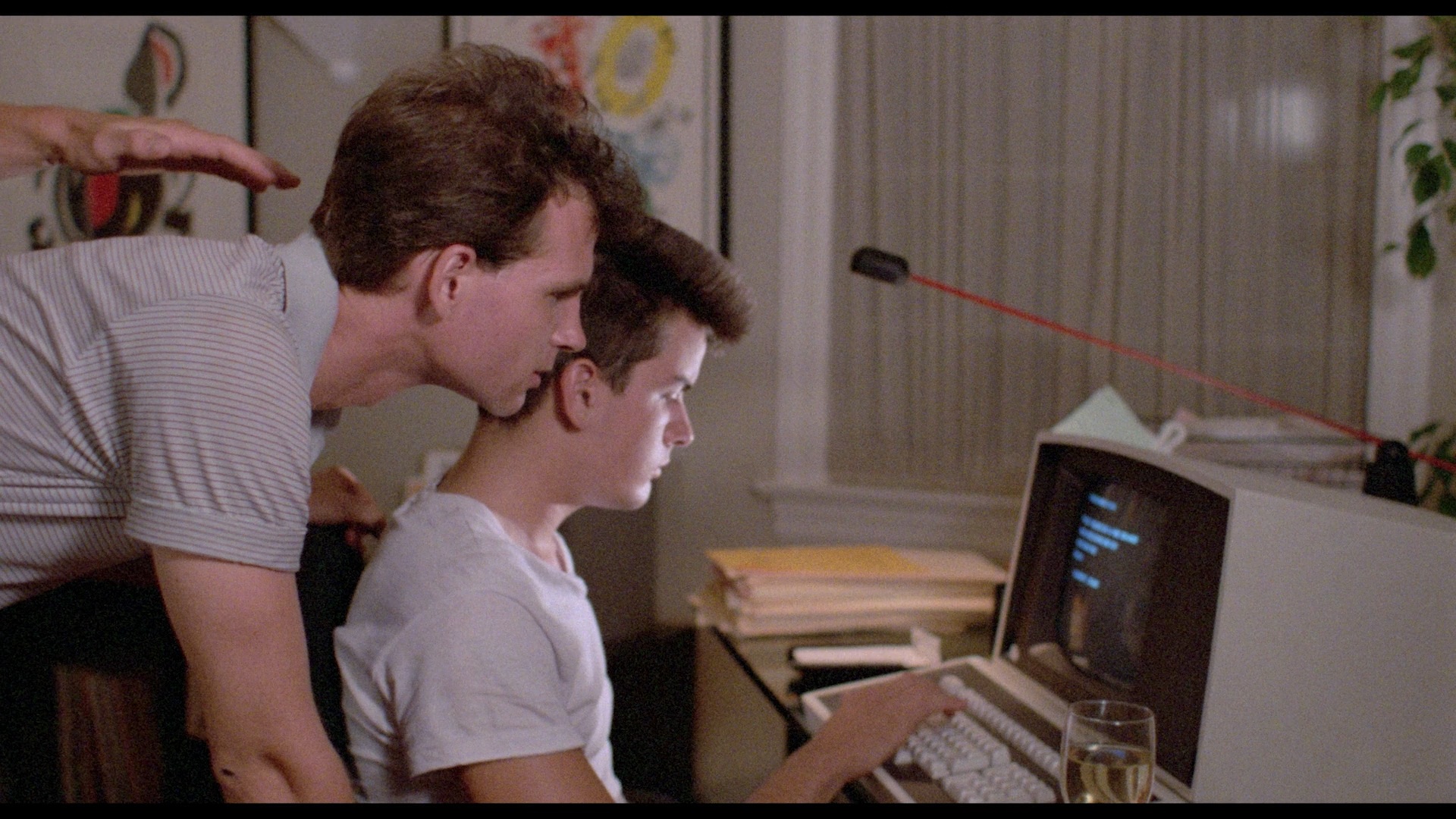 and optional English SDH subtitles are provided. The original commentary is ported over here along with the trailer, but you get several new featurettes as well. In "Blind Rage" (24m59s), Stephen Thrower analyzes the film's place in Spheeris' filmography (which later included her hitting the big time with the fractious production of Wayne's World), her treatment of American subcultures, the handling of what was very extensive and daring gay material for a mid-'80s mainstream film, and the power the film still holds. In "Both Sides of the Law" (19m41s), Caulfield and McDonald sit down together for a reminiscence about their second film together, the public perception of real-life killers at the time, their response to the film, the process of doing research and prepping with Spheeris, and memories of working with Sheen. In "Give Us Your Money" (5m48s), street band performers Texacala Jones and Tequila Mockingbird briefly go into their L.A. music backgrounds at the time, their encounters with Spheeris on the scene and being aware of her from her prior films, and their recruiting to appear in this film. In "Caveman Day" (20m47s), Spheeris and Caulfield reunite in 2015 for a Cinemaniacs screening in Melbourne and reflect on the film's treatment of violence and how it might be executed and received differently today as well as the influences leading up to it. Then in "Tales from the End Zone" (12m18s), actor Kenneth Courtland looks back doing his first film here, his positive impressions of Spheeris, the creative process of putting the film together under a free atmosphere, his positive response to the handling of multiple gay characters including his working with actor Paul Dancer, and the reason they kept their distance with the two stars. "The Psychotronic Tourist" (13m39s) with Kier-la Janisse provides a then-and-now look at the filming locations for the film around the L.A. area including notes about other films shot in the same spots and other bits of related cinematic trivia. Finally you get an alternate and more appropriate title sequence (40s) under the title Blind Rage and two extended sequences (1m1s, 1m23s).
and optional English SDH subtitles are provided. The original commentary is ported over here along with the trailer, but you get several new featurettes as well. In "Blind Rage" (24m59s), Stephen Thrower analyzes the film's place in Spheeris' filmography (which later included her hitting the big time with the fractious production of Wayne's World), her treatment of American subcultures, the handling of what was very extensive and daring gay material for a mid-'80s mainstream film, and the power the film still holds. In "Both Sides of the Law" (19m41s), Caulfield and McDonald sit down together for a reminiscence about their second film together, the public perception of real-life killers at the time, their response to the film, the process of doing research and prepping with Spheeris, and memories of working with Sheen. In "Give Us Your Money" (5m48s), street band performers Texacala Jones and Tequila Mockingbird briefly go into their L.A. music backgrounds at the time, their encounters with Spheeris on the scene and being aware of her from her prior films, and their recruiting to appear in this film. In "Caveman Day" (20m47s), Spheeris and Caulfield reunite in 2015 for a Cinemaniacs screening in Melbourne and reflect on the film's treatment of violence and how it might be executed and received differently today as well as the influences leading up to it. Then in "Tales from the End Zone" (12m18s), actor Kenneth Courtland looks back doing his first film here, his positive impressions of Spheeris, the creative process of putting the film together under a free atmosphere, his positive response to the handling of multiple gay characters including his working with actor Paul Dancer, and the reason they kept their distance with the two stars. "The Psychotronic Tourist" (13m39s) with Kier-la Janisse provides a then-and-now look at the filming locations for the film around the L.A. area including notes about other films shot in the same spots and other bits of related cinematic trivia. Finally you get an alternate and more appropriate title sequence (40s) under the title Blind Rage and two extended sequences (1m1s, 1m23s).
Reviewed on July 27, 2025

 with her first The Decline of Western Civilization documentary and the acclaimed Suburbia for Roger Corman,
with her first The Decline of Western Civilization documentary and the acclaimed Suburbia for Roger Corman,  unpredictable pop culture chronicler Penelope Spheeris turned her eye to teen crime with another counterculture-infused feature. In 1985, teen movies hadn't quite gone noir yet and were still in their optimistic John Hughes phase; titles like Heathers, Wisdom, Kansas, Out of Bounds, and No Man's Land were lurking just around the corner. One of the first and best out of the gate, The Boys Next Door is an extremely dark buddy road movie written by the team of Glen Morgan and James Wong, who went on to glory with 21 Jump Street, The X-Files, and Final Destination. Essentially it's a crime spree film like Gun Crazy updated for the Reagan era, depicting how the American promise of prosperity for all very quickly turned out to be a hollow one for millions of rootless middle- and lower-class youths. Seen today it's also impossible not to think about the real-life dumpster fire of star Charlie Sheen's life as well as the dramatic increase in teenage homicides since then, and if you were told this was based on a true crime case, it would be very easy to believe.
unpredictable pop culture chronicler Penelope Spheeris turned her eye to teen crime with another counterculture-infused feature. In 1985, teen movies hadn't quite gone noir yet and were still in their optimistic John Hughes phase; titles like Heathers, Wisdom, Kansas, Out of Bounds, and No Man's Land were lurking just around the corner. One of the first and best out of the gate, The Boys Next Door is an extremely dark buddy road movie written by the team of Glen Morgan and James Wong, who went on to glory with 21 Jump Street, The X-Files, and Final Destination. Essentially it's a crime spree film like Gun Crazy updated for the Reagan era, depicting how the American promise of prosperity for all very quickly turned out to be a hollow one for millions of rootless middle- and lower-class youths. Seen today it's also impossible not to think about the real-life dumpster fire of star Charlie Sheen's life as well as the dramatic increase in teenage homicides since then, and if you were told this was based on a true crime case, it would be very easy to believe.

 main title sequence showcasing real-life serial killers (imposed by producer Sandy Howard of Angel fame), we meet our two protagonists on the cusp of graduating from high school: Roy (Caulfield) and Bo (Sheen), who draw a prank
main title sequence showcasing real-life serial killers (imposed by producer Sandy Howard of Angel fame), we meet our two protagonists on the cusp of graduating from high school: Roy (Caulfield) and Bo (Sheen), who draw a prank  dead body outline at school to cause a ruckus. Confronted with either heading into the military or taking manual labor jobs, they decide to use their graduation money after an uncomfortable pool party to take an impulsive trip to L.A. and inflict escalating acts of violence against those they encounter. A savage beating at a gas station puts the police (including Caulfield's previous Grease 2 co-star, Christopher McDonald) on their trail, and what was supposed to be a trip to the beach and Hollywood turns into a manhunt and further brutal robberies.
dead body outline at school to cause a ruckus. Confronted with either heading into the military or taking manual labor jobs, they decide to use their graduation money after an uncomfortable pool party to take an impulsive trip to L.A. and inflict escalating acts of violence against those they encounter. A savage beating at a gas station puts the police (including Caulfield's previous Grease 2 co-star, Christopher McDonald) on their trail, and what was supposed to be a trip to the beach and Hollywood turns into a manhunt and further brutal robberies. Caulfield. It's a great chronicle of the making of the film including other prospective cast members (like Crispin Glover), the changes necessitated to avoid an X rating especially in the gas station scene, the stories behind some of the song choices, the film's roles in their lives since its release, and lots more. Severin Films brought the film to Blu-ray in 2019 with a reissue in 2025 as a UHD and Blu-ray set, with the latter obviously being the way to go since the HDR10-augmented transfer looks about as crisp and vivid as you could possibly want. The DTS-HD MA 5.1 and 2.0 stereo English tracks both sound good with the music obviously getting most of the separation here,
Caulfield. It's a great chronicle of the making of the film including other prospective cast members (like Crispin Glover), the changes necessitated to avoid an X rating especially in the gas station scene, the stories behind some of the song choices, the film's roles in their lives since its release, and lots more. Severin Films brought the film to Blu-ray in 2019 with a reissue in 2025 as a UHD and Blu-ray set, with the latter obviously being the way to go since the HDR10-augmented transfer looks about as crisp and vivid as you could possibly want. The DTS-HD MA 5.1 and 2.0 stereo English tracks both sound good with the music obviously getting most of the separation here,  and optional English SDH subtitles are provided. The original commentary is ported over here along with the trailer, but you get several new featurettes as well. In "Blind Rage" (24m59s), Stephen Thrower analyzes the film's place in Spheeris' filmography (which later included her hitting the big time with the fractious production of Wayne's World), her treatment of American subcultures, the handling of what was very extensive and daring gay material for a mid-'80s mainstream film, and the power the film still holds. In "Both Sides of the Law" (19m41s), Caulfield and McDonald sit down together for a reminiscence about their second film together, the public perception of real-life killers at the time, their response to the film, the process of doing research and prepping with Spheeris, and memories of working with Sheen. In "Give Us Your Money" (5m48s), street band performers Texacala Jones and Tequila Mockingbird briefly go into their L.A. music backgrounds at the time, their encounters with Spheeris on the scene and being aware of her from her prior films, and their recruiting to appear in this film. In "Caveman Day" (20m47s), Spheeris and Caulfield reunite in 2015 for a Cinemaniacs screening in Melbourne and reflect on the film's treatment of violence and how it might be executed and received differently today as well as the influences leading up to it. Then in "Tales from the End Zone" (12m18s), actor Kenneth Courtland looks back doing his first film here, his positive impressions of Spheeris, the creative process of putting the film together under a free atmosphere, his positive response to the handling of multiple gay characters including his working with actor Paul Dancer, and the reason they kept their distance with the two stars. "The Psychotronic Tourist" (13m39s) with Kier-la Janisse provides a then-and-now look at the filming locations for the film around the L.A. area including notes about other films shot in the same spots and other bits of related cinematic trivia. Finally you get an alternate and more appropriate title sequence (40s) under the title Blind Rage and two extended sequences (1m1s, 1m23s).
and optional English SDH subtitles are provided. The original commentary is ported over here along with the trailer, but you get several new featurettes as well. In "Blind Rage" (24m59s), Stephen Thrower analyzes the film's place in Spheeris' filmography (which later included her hitting the big time with the fractious production of Wayne's World), her treatment of American subcultures, the handling of what was very extensive and daring gay material for a mid-'80s mainstream film, and the power the film still holds. In "Both Sides of the Law" (19m41s), Caulfield and McDonald sit down together for a reminiscence about their second film together, the public perception of real-life killers at the time, their response to the film, the process of doing research and prepping with Spheeris, and memories of working with Sheen. In "Give Us Your Money" (5m48s), street band performers Texacala Jones and Tequila Mockingbird briefly go into their L.A. music backgrounds at the time, their encounters with Spheeris on the scene and being aware of her from her prior films, and their recruiting to appear in this film. In "Caveman Day" (20m47s), Spheeris and Caulfield reunite in 2015 for a Cinemaniacs screening in Melbourne and reflect on the film's treatment of violence and how it might be executed and received differently today as well as the influences leading up to it. Then in "Tales from the End Zone" (12m18s), actor Kenneth Courtland looks back doing his first film here, his positive impressions of Spheeris, the creative process of putting the film together under a free atmosphere, his positive response to the handling of multiple gay characters including his working with actor Paul Dancer, and the reason they kept their distance with the two stars. "The Psychotronic Tourist" (13m39s) with Kier-la Janisse provides a then-and-now look at the filming locations for the film around the L.A. area including notes about other films shot in the same spots and other bits of related cinematic trivia. Finally you get an alternate and more appropriate title sequence (40s) under the title Blind Rage and two extended sequences (1m1s, 1m23s).